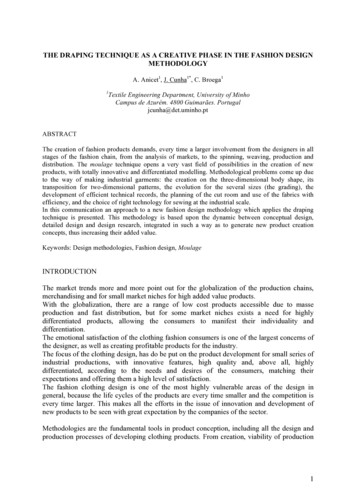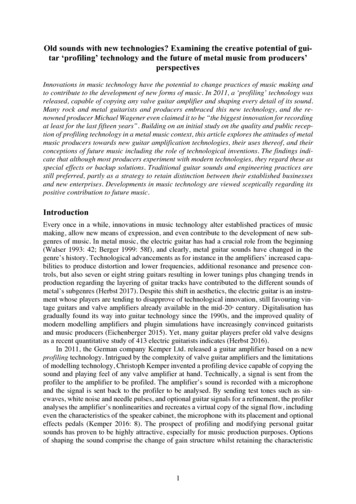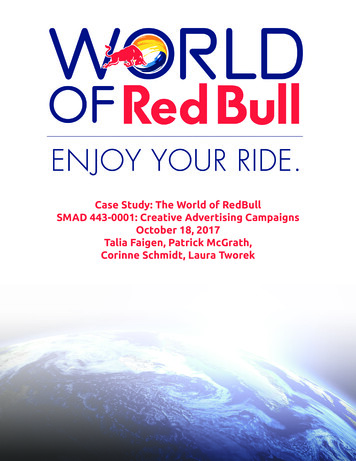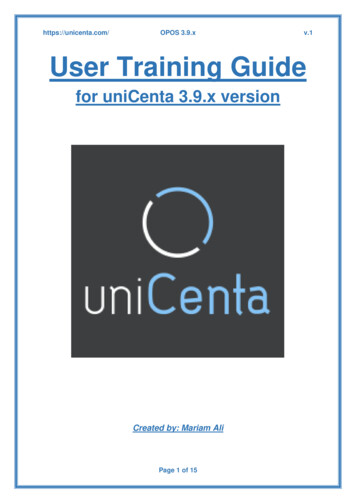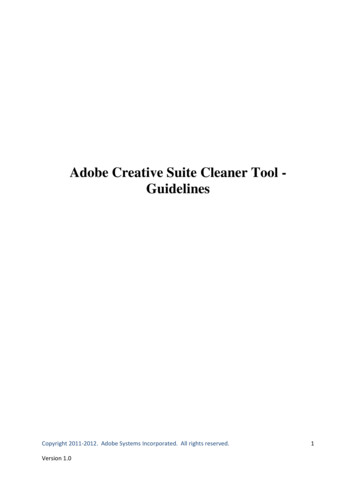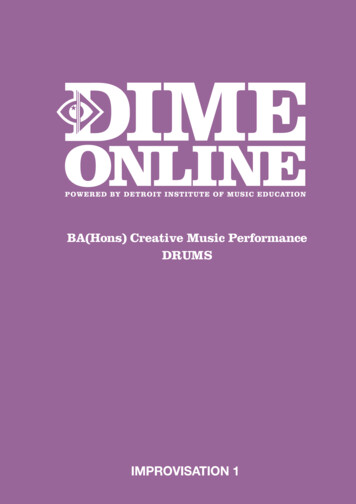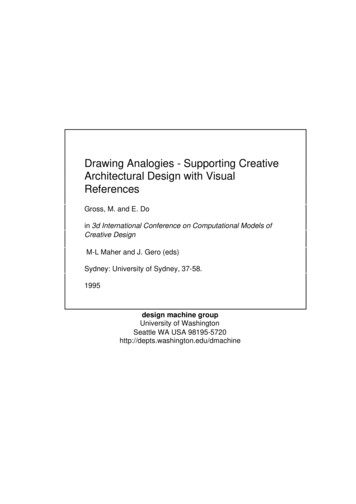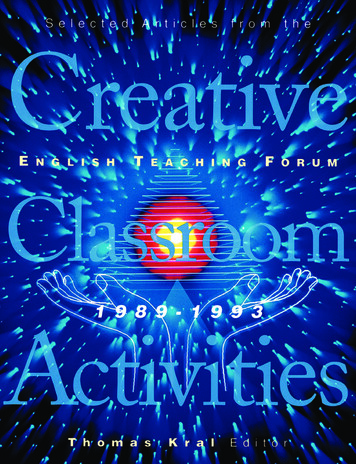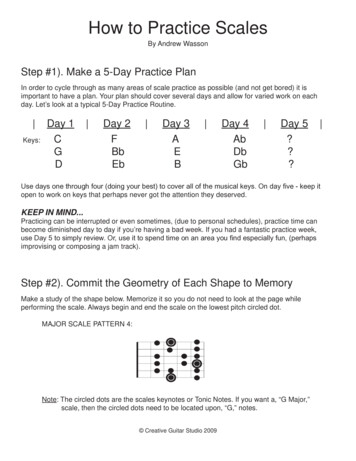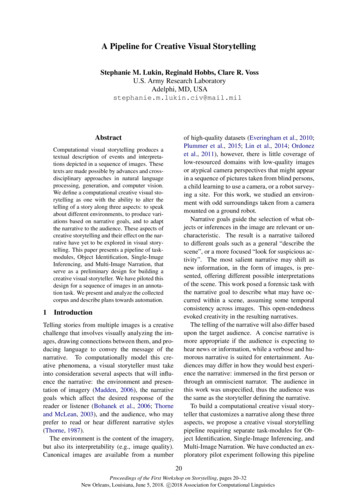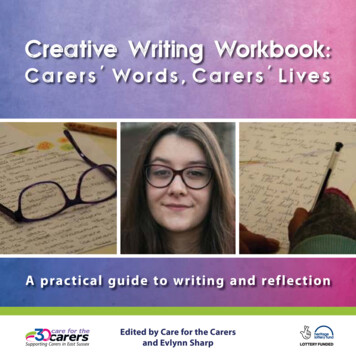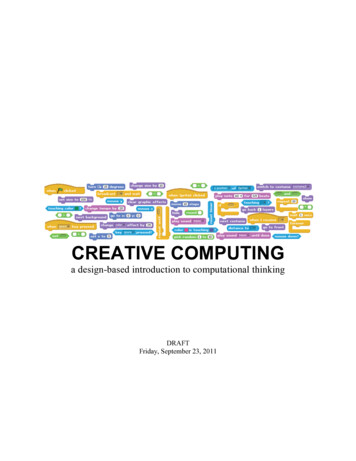
Transcription
CREATIVE COMPUTINGa design-based introduction to computational thinkingDRAFTFriday, September 23, 2011
Table of contentsBackground.3What is this guide? .3Who is the guide for? .3What do I need in order to use this guide? .4How should I use this guide? .4Where did this guide come from? .4Structure.5Daily Overview .6Computational Thinking Connections .8Assessment .12Standards .13Sessions.15Session #1 .15Session #2 .18Session #3 .20Session #4 .22Session #5 .24Session #6 .25Session #7 .27Session #8 .29Session #9 .30Session #10 .31Session #11 .33Session #12 .35Session #13 .36Session #14 .38Session #15 .40Session #16 .41Session #17 .42Session #18 .43Session #19 .44Session #20 .45Appendix: Links.46Appendix: Handouts .47
DRAFT - 20110923BackgroundWhat is this guide?This guide provides an introduction to creative computing with Scratch, using a design-basedlearning approach. It is organized as a series of twenty 60-minute sessions, and includes sessionplans, handouts, projects, and videos.What is creative computing?Creative computing is about creativity. Computer science and computing-related fields have longbeen perceived as being disconnected from young people’s interests and values. Creativecomputing supports the development of personal connections to computing, by drawing uponcreativity, imagination, and interests.Creative computing is about computing. Many young people with access to computersparticipate as consumers, rather than designers or creators. Creative computing emphasizes theknowledge and practices that young people need to create the types of dynamic and interactivecomputational media that they enjoy in their daily lives.Engaging in the creation of computational artifacts prepares young people for more than careersas computer scientists or as programmers. It supports young people’s development ascomputational thinkers – individuals who can draw on computational concepts, practices, andperspectives in all aspects of their lives, across disciplines and contexts.The activities in this guide are designed to explore computational thinking concepts (sequence,loops, parallelism, events, conditionals, operators, data), practices (working iteratively andincrementally, testing and debugging, reusing and remixing, abstracting and modularizing), andperspectives (expressing, connecting, questioning).What is design-based learning?Design-based learning is an approach that emphasizes designing (creating things, not just usingor interacting with things), personalizing (creating things that are personally meaningful andrelevant), collaborating (working with others on creations), and reflecting (reviewing andrethinking one’s creative practices). As such, a design-based approach to learning is particularlywell suited to creative computing, and forms the basis for the design of each session described inthis guide.Who is the guide for?This guide is for any teacher who wants to support students’ development of computationalthinking through explorations with Scratch. Scratch is already being used by many educators3
DRAFT - 20110923across a wide range of contexts, so we wrote the guide to be both subject-neutral and gradeneutral to accommodate different settings.We rely on teachers to make the connections between the context of their learning environmentand the activities that are described in this guide – and we hope to document some of theseconnections to share in future iterations of the guide.What do I need in order to use this guide?In addition to time, some important resources include: computers with speakers (and, optionally, microphones and webcams): for the computerbased design activities projector or interactive whiteboard with speakers: for sharing works-in-progress and fordemonstrations network connection: for connecting to the Scratch and ScratchEd online communities design notebooks (physical or digital): for documenting, sketching, and brainstormingideas and plansHow should I use this guide?We are releasing this guide under a Creative Commons Attribution-ShareAlike license, whichmeans that you are completely free to use, change, and share this work, as long as you provideappropriate attribution and give others similar access to any derivative works.Feel free to design new activities and to remix the included activities. Of course, we’d love tolearn about what you’re doing, so we encourage you to document and share your experienceswith us and with other educators via the ScratchEd community at http://scratched.media.mit.eduWhere did this guide come from?This guide was written by Karen Brennan, with significant contributions from Michelle Chungand Jeff Hawson. Stephanie Gayle provided significant review and feedback.The guide’s content is based on four years of Scratch educator workshops, particularly theGoogle-funded 2009-2011 Creative Computing workshops that were co-hosted with ProfessorMitchel Resnick and, more recently, NSF-funded ScratchEd workshops and meetups.Many thanks to everyone who has made this guide possible, including the thousands of amazingworkshop participants and ScratchEd online community members, and the members and friendsof the ScratchEd and Scratch teams.4
DRAFT - 20110923StructureThe 20 sessions presented in this guide are organized into five topics, as a way for students toexplore different genres of creative expression and form, while developing familiarity andfluency with computational concepts and practices.TopicIntroductionDescriptionStudents are introduced to creative computing andScratch, through sample projects and hands-onexperiences.ArtsStudents explore the arts by creating projects that includeelements of music, design, drawing, and dance.# of Sessions23The computational concepts of sequence and loops, andthe computational practices of being iterative andincremental are highlighted.StoriesStudents explore storytelling by creating projects thatinclude characters, scenes, and narrative.3The computational concepts of parallelism and events andthe computational practices of reusing and remixing arehighlighted.GamesStudents explore games by creating projects that definegoals and rules.4The computational concepts of conditionals, operators,and data, and the computational practices of testing anddebugging are highlighted.Final projectStudents develop independent projects by defining aproject to work on, collaborating with others to improvethe project, and presenting the project and its developmentprocess.The computational practices of abstracting andmodularizing are highlighted.58
DRAFT - 20110923Daily OverviewTopicIntroductionSession #12Arts345Stories678Games9101112Final project1314ActivityPlanning: What is creative computing?Planning: Defining computational design processesExploring: Something surprisingReflecting: Our discoveriesReflecting: Design notebook questionCreating: About meReflecting: My design processReflecting: Design notebook questionConnecting: My favorite songExploring: Programmed to danceReflecting: Step by stepReflecting: Design notebook questionCreating: Dance partyReflecting: How did you do that?Reflecting: Design notebook questionCreating: Open-ended designing (arts)Reflecting: Design notebook questionConnecting: Six-word storyExploring: Performing scriptsReflecting: All together nowReflecting: Design notebook questionConnecting: Creature constructionCreating: Pass-it-onReflecting: Design notebook questionCreating: Open-ended designing (stories)Reflecting: Design notebook questionExploring: Debug it!Reflecting: Comparing debugging strategiesReflecting: Design notebook questionConnecting: Games brainstormCreating: A-maze-ingReflecting: Design notebook questionCreating: Maze extensionsReflecting: Here’s what I figured outReflecting: Design notebook questionCreating: Open-ended designing (games)Reflecting: Design notebook questionPlanning: Preparing for the final projectReflecting: Design notebook questionExploring: Special-interest groups6
DRAFT - 20110923151617181920Creating: Open-ended designingReflecting: Design notebook questionCreating: Open-ended designingReflecting: Design notebook questionExploring: Critique groupsCreating: Open-ended designingReflecting: Design notebook questionCreating: Open-ended designingReflecting: Design notebook questionCreating: Open-ended designingPlanning: Preparing for the final project reflectionReflecting: Design notebook questionCreating: Open-ended designingReflecting: Design notebook questionReflecting: Celebration and final project reflectionsEach session plan contains the following elements: session description: a brief summary of the session’s activitiesobjectives: a list of things that students will be able to know, do, or feel through thesession’s activitiessession activities summary: an outline of the sessionresources: a list of (required and optional) session resourcessession description: a detailed description of the session activities, including duration andstudent/facilitator actionso each session description begins with a reflective design notebook question, somethingthat students can get started on as soon as they arriveo the remainder of the session description consists of different types of activities,including planning, connecting, exploring, creating, and reflecting activitiesnotes: each session plan ends with a few reflective notes – points of common confusion,explanations of approaches, or suggestions for alternative strategies7
DRAFT - 20110923Computational Thinking ConnectionsThe following tables summarize the computational thinking framework and define its constituentcomponents.Computational tionalsoperatorsdataDescriptionidentifying a series of steps for a taskrunning the same sequence multiple timesmaking things happen at the same timeone thing causing another thing to happenmaking decisions based on conditionssupport for mathematical and logical expressionsstoring, retrieving, and updating valuesComputational PracticesPracticebeing iterative andincrementaltesting anddebuggingDescriptiondeveloping a little bit, then trying it out, then developing some moremaking sure that things work – and finding and fixing mistakesreusing and remixing making something by building on what others – or you – have doneabstracting andmodularizingbuilding something large by putting together collections of smaller partsComputational ing that computation is a medium of creation“I can create.”connectingrecognizing the power of creating with and for others“I can do different things when I have access to others.”questioningfeeling empowered to ask questions about the world“I can (use computation to) ask questions to make sense of(computational things in) the world.”8
DRAFT - 20110923Although the computational thinking concepts, practices, and perspectives are engagedthroughout the curriculum guide activities, there are particular activities in which they areengaged more explicitly. The following tables highlight the activities in which computationalconcepts and computational practices are: introduced (marked with an I),discussed (marked with a D), andexplored (marked with an s4conditionals3events2ActivityPlanning: What is creative computing?Planning: Defining computational design processesExploring: Something surprisingReflecting: Our discoveriesReflecting: Design notebook questionCreating: About meReflecting: My design processReflecting: Design notebook questionConnecting: My favorite songExploring: Programmed to danceReflecting: Step by stepReflecting: Design notebook questionCreating: Dance partyReflecting: How did you do that?Reflecting: Design notebook questionCreating: Open-ended designing (arts)Reflecting: Design notebook questionConnecting: Six-word storyExploring: Performing scriptsReflecting: All together nowReflecting: Design notebook questionConnecting: Creature constructionCreating: Pass-it-onReflecting: Design notebook questionCreating: Open-ended designing (stories)Reflecting: Design notebook questionExploring: Debug it!parallelism1sequenceSession #Computational Concepts
DRAFT - 201109231011121314151617181920Reflecting: Comparing debugging strategiesReflecting: Design notebook questionConnecting: Games brainstormCreating: A-maze-ingReflecting: Design notebook questionCreating: Maze extensionsReflecting: Here’s what I figured outReflecting: Design notebook questionCreating: Open-ended designing (games)Reflecting: Design notebook questionPlanning: Preparing for the final projectReflecting: Design notebook questionExploring: Special-interest groupsCreating: Open-ended designingReflecting: Design notebook questionCreating: Open-ended designingReflecting: Design notebook questionExploring: Critique groupsCreating: Open-ended designingReflecting: Design notebook questionCreating: Open-ended designingReflecting: Design notebook questionCreating: Open-ended designingPlanning: Preparing for the final project reflectionReflecting: Design notebook questionCreating: Open-ended designingReflecting: Design notebook questionReflecting: Celebration and final project EEEEEEEEEEEEEEEEEEEEEEEEEEEEEEEEEEEE
DRAFT - 201109232345678910111211abstracting andmodularizingIEDtesting anddebuggingActivityPlanning: What is creative computing?Planning: Defining computational design processesExploring: Something surprisingReflecting: Our discoveriesReflecting: Design notebook questionCreating: About meReflecting: My design processReflecting: Design notebook questionConnecting: My favorite songExploring: Programmed to danceReflecting: Step by stepReflecting: Design notebook questionCreating: Dance partyReflecting: How did you do that?Reflecting: Design notebook questionCreating: Open-ended designing (arts)Reflecting: Design notebook questionConnecting: Six-word storyExploring: Performing scriptsReflecting: All together nowReflecting: Design notebook questionConnecting: Creature constructionCreating: Pass-it-onReflecting: Design notebook questionCreating: Open-ended designing (stories)Reflecting: Design notebook questionExploring: Debug it!Reflecting: Comparing debugging strategiesReflecting: Design notebook questionConnecting: Games brainstormCreating: A-maze-ingReflecting: Design notebook questionCreating: Maze extensionsReflecting: Here’s what I figured outReflecting: Design notebook questionreusing andremixing1being iterative andincrementalSession #Computational PracticesIIIEDEDDEDDDEEEEDEEEEEDEEEED
DRAFT - 20110923Creating: Open-ended designing (games)Reflecting: Design notebook questionPlanning: Preparing for the final projectReflecting: Design notebook questionExploring: Special-interest groupsCreating: Open-ended designingReflecting: Design notebook questionCreating: Open-ended designingReflecting: Design notebook questionExploring: Critique groupsCreating: Open-ended designingReflecting: Design notebook questionCreating: Open-ended designingReflecting: Design notebook questionCreating: Open-ended designingPlanning: Preparing for the final project reflectionReflecting: Design notebook questionCreating: Open-ended designingReflecting: Design notebook questionReflecting: Celebration and final project EEEEDEDEEEEDEComputational PerspectivesComputational perspectives are not addressed explicitly in the curriculum guide, but areintroduced and explored indirectly through discussion questions and design journal prompts.AssessmentOur approach to assessment is process-oriented, with a focus on creating opportunities forstudents to talk about their own (and others’) creations and creative practices. There are manyforms of process-oriented data that could be collected and various strategies are suggestedthroughout the guide, such as: supporting conversations with and among students about their projects, recorded throughaudio, video, or text (such as the project planner handout from Session #13, the projectcritique handout from Session #16, or the project reflections handout from Session #18)examining portfolios of projectsmaintaining design journalsWe view assessment as something that is done with students, to support their understanding ofwhat they know and what they still want to know. Assessment can involve a variety ofparticipants, including the creators, their peers, teacher, parents, and others.12
DRAFT - 20110923StandardsThe sessions and activities in this guide make connections to several different K-12 curriculumstandards, including: CSTA K-12 Computer Science Standards dsReview2011.pdfo Computational thinking – Algorithms (Levels 1A, 1B, 2)o Computational thinking – Problem solving (Levels 1A, 1B, 2)o Computational thinking – Abstraction (Levels 1B, 2)o Computational thinking – Connections (Levels 1B, 2)o Collaboration – Tools (Levels 1A, 1B, 2)o Collaboration – Endeavor (Levels 1A, 1B, 2, 3A)o Practice and programming – Learning (Levels 1A, 1B, 2)o Practice and programming – Tools for creation (Levels 1A, 1B, 2)o Practice and programming – Programming (Levels 1A, 1B, 2, 3A)o Practice and programming – Careers (Levels 1A, 1B, 2)o Community, Global, and Ethical Impacts – Responsible use (Levels 1A – 3B) ISTE NETS Student Standards s/nets-student-standards-2007.aspxo Creativity and Innovation – Students demonstrate creative thinking, constructknowledge, and develop innovative products and processes using technology.Students: apply existing knowledge to generate new ideas, products, or processes. create original works as a means of personal or group expression.o Communication and Collaboration – Students use digital media and environments tocommunicate and work collaboratively, including at a distance, to support individuallearning and contribute to the learning of others. Students: interact, collaborate, and publish with peers, experts, or others employing avariety of digital environments and media. communicate information and ideas effectively to multiple audiences using avariety of media and formats. contribute to project teams to produce original works or solve problems.o Research and Information Fluency – Students apply digital tools to gather, evaluate,and use information. Students: plan strategies to guide inquiry. locate, organize, analyze, evaluate, synthesize, and ethically use information froma variety of sources and media. evaluate and select information sources and digital tools based on theappropriateness to specific tasks.o Critical Thinking, Problem Solving, and Decision Making – Students use criticalthinking skills to plan and conduct research, manage projects, solve problems, andmake informed decisions using appropriate digital tools and resources. Students: identify and define authentic problems and significant questions for investigation. plan and manage activities to develop a solution or complete a project.13
DRAFT - 20110923 collect and analyze data to identify solutions and/or make informed decisions. use multiple processes and diverse perspectives to explore alternative solutions.o Digital Citizenship – Students understand human, cultural, and societal issues relatedto technology and practice legal and ethical behavior. Students: advocate and practice safe, legal, and responsible use of information andtechnology. exhibit a positive attitude toward using technology that supports collaboration,learning, and productivity. demonstrate personal responsibility for lifelong learning.o Technology Operations and Concepts – Students demonstrate a sound understandingof technology concepts, systems, and operations. Students: understand and use technology systems. select and use applications effectively and productively. troubleshoot systems and applications.14
DRAFT - 20110923SessionsSession #1Session descriptionIn this session, students are introduced to computational creation with the Scratch programmingenvironment by viewing a collection of sample projects and engaging in an exploratory, handson experience.ObjectivesThe students will: understand the concept of computational creation, in the context of Scratch be able to imagine possibilities for their own Scratch-based computational creation become familiar with resources that support their computational creationSession activities summary Introduce the concept of computational creation and the Scratch environment Show sample Scratch projects Review design processes Explore the Scratch interfaceResources Scratch overview video (optional)http://vimeo.com/29457909 Collection of sample projects Designnotebooks(maybedigital)Resources library items (Scratchcards, etc.)Session description Min.Activities15Planning: What is creative computing? Ask students:o What are the different ways you interact with computers?o How many of those ways involve you creating with computers? Explain that over the next several sessions they will be creating their owninteractive computational media with Scratch. Show a basic demo of Scratch, either through a live demo or through the Scratchoverview video.o You build projects by snapping blocks together, just as you can build things inthe physical world by snapping LEGO bricks together.o There are more than 100 blocks in 8 different categories.o As a small example, let’s make the cat do a dance.o Start by dragging out the “move 10 steps” block from the “Motion” blockspalette to the scripting area. Every time you click on the block the cat moves adistance of 10. You can change the number to make the cat move a greater orsmaller distance.15
DRAFT - 20110923 o From the “Sound” palette, drag out the “play drum” block. Click on the blockto hear its drum sound. Drag and snap the “play drum” block below the“move“ block. When you click on this stack of two blocks, the cat will moveand then play the drum sound.o Copy this stack of blocks (either using the Duplicate toolbar item or by rightclicking the stack and selecting “duplicate”) and snap the copy to the alreadyplaced blocks. Change the second “move” block to -10 steps, so the cat movesbackward. Every time the stack of four blocks is clicked, the cat does a littledance forward and back.o Go to the “Control” blocks palette and grab the “repeat” block. Wrap the“repeat” block around the other blocks in the scripting area. Now when youclick on the stack, the cat dances forward and back 10 times.o Finally, drag the “when Sprite clicked” block and snap it to the top of thestack. Click on the cat (instead of the blocks stack) to make the cat dance.Show the range of projects they will be able to create, by sharing some sampleprojects that students will find engaging and inspiring. The Scratch website(http://scratch.mit.edu) has many interesting examples.15Planning: Defining the processes of computational design Introduce students to the other tools that they will have access to during theirdesign activities:o Design notebook, for recording their ideas and plans, as well as for respondingto the per-session design notebook questiono Resource library, for accessing other forms of support, such as Scratch cards,or reminders of strategies for getting unstucko Scratch website, for storing their projects and finding inspiration and help10Exploring: Something surprising Give students 10 minutes to explore the Scratch interface in an open-ended way.One prompt is: “You have 10 minutes to make something surprising happen to asprite.” Students are encouraged to work together, ask each other for help, andshare what they are figuring out during the 10 minutes.20Reflecting: Our discoveries Ask for 3 or 4 volunteers to share with the entire group one thing that theydiscovered. Optionally, after the volunteers have shared, offer several challenges to thestudents:o Did anyone figure out how to add sound?o Did anyone figure out how to change the background?o Did anyone figure out how to access the help screens for particular blocks?16
DRAFT - 20110923NotesA major goal of this session is to establish a culture of fearlessness, exploration, and peercollaboration. It is expected that students (and their teachers!) will not know everything ahead oftime – and the environment becomes a space where everyone is learning together.17
DRAFT - 20110923Session #2Session descriptionIn this session, students build on their initial explorations of the Scratch environment by creatingan interactive project.ObjectivesThe students will: become familiar with a wider range of Scratch blocks be able to create a Scratch project that is an interactive digital representation of theirinterestsSession activities summary Respond to design notebook question Create Scratch biography projects Share and discuss creationsResources About me handout About me sample projects(optional)Session description Min.Activities5Reflecting: Design notebook question What are three aspects of yourself that you could represent through images orsound?40Creating: About me Introduce students to the concept of the interactive collage, a Scratch project thatrepresents aspects of themselves through clickable sprites. Optionally, show acouple of different interactive “About me” projects. Give students 35 minutes to work on their projects, with the “About me” handoutavailable to provide guidance for blocks to experiment with.15Reflecting: My design process Invite 2 or 3 students to share their “About me” projects and encourage others toask questions about their design process:o What was your inspiration?o How did you do that?o What did you get stuck on? How did you get unstuck?o What are you most proud of? Why?o What might you want to do next? Ask students to post their projects on the Scratch website. (optional)18
DRAFT - 20110923NotesExample projects can simultaneously inspire and intimidate, open the creative space andconstrain it. Encourage a wide range of creations – diversity is great.19
DRAFT - 20110923Session #3Session descriptionIn this session, students explore the concepts of instruction and sequence through the arts: music,design, drawing, and dance.ObjectivesThe students will: learn to express a complex activity using a seque
Sep 23, 2011 · This guide provides an introduction to creative computing with Scratch, using a design-based learning approach. It is organized as a series of twenty 60-minute sessions, and includes session plans, handouts, projects, and videos. What is creative computing? Creative computing is about creativity. Computer
